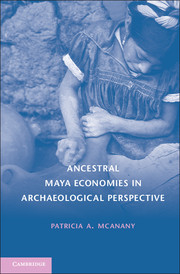Book contents
- Frontmatter
- Dedication
- Contents
- List of Figures
- Preface and Acknowledgments
- 1 The Materiality of Practice in Ancestral Maya Economies
- 2 Situating Maya Societies in Space and Time
- 3 Feeding a Hungry Landscape
- 4 Gendered Labor and Socially Constructed Space
- 5 Ritual Works: Monumental Architecture and Generative Schemes of Power
- 6 Naturalized Authority of the Royal Court
- 7 Social Identity and the Daily Practice of Artisan Production
- 8 Places, Practices, and People of Commerce
- 9 Flowery Speech of Maya Tributary Arrangements
- 10 Skeining the Threads
- References Cited
- Index
2 - Situating Maya Societies in Space and Time
Published online by Cambridge University Press: 05 December 2014
- Frontmatter
- Dedication
- Contents
- List of Figures
- Preface and Acknowledgments
- 1 The Materiality of Practice in Ancestral Maya Economies
- 2 Situating Maya Societies in Space and Time
- 3 Feeding a Hungry Landscape
- 4 Gendered Labor and Socially Constructed Space
- 5 Ritual Works: Monumental Architecture and Generative Schemes of Power
- 6 Naturalized Authority of the Royal Court
- 7 Social Identity and the Daily Practice of Artisan Production
- 8 Places, Practices, and People of Commerce
- 9 Flowery Speech of Maya Tributary Arrangements
- 10 Skeining the Threads
- References Cited
- Index
Summary
While looking for the “spice islands” of the East Indies, Christopher Columbus – on his fourth voyage to the Americas in 1502 – found the eastern Caribbean limits of the Maya world. As he sailed into the Bay of Honduras (Figure 2.1), his crew spotted and boarded a large cargo canoe transporting – among many other goods – sacks of cacao, described as “ much as almendras de cacao ” or many almond-sized chocolate seeds (Casas 1877, Book 2, Chapter 20:274). This was the first European encounter with a people who would come to be called Maya and a foodstuff that would become a premier luxury and comfort food the world over. Subsequent sixteenth-century explorers, such as Juan de Grijalva, encountered the low limestone peninsula of the Maya lowlands farther north, near Tulum, and then sailed north and west along the northern edge of the Yucatán Peninsula into the Gulf of Mexico (Figure 2.1). The infamous voyage of 1519, that of Hernán Cortes, followed a similar tack, stopping briefly at the island of Cozumel, and then continuing around the top of the peninsula ultimately to set ashore well to the west of the Maya region in Veracruz. From this point, Cortes and his conquistadores made their assault on the highland Mexican imperial capital of Tenochtitlán, home of the Mexica or Aztecs.
- Type
- Chapter
- Information
- Ancestral Maya Economies in Archaeological Perspective , pp. 25 - 59Publisher: Cambridge University PressPrint publication year: 2010

